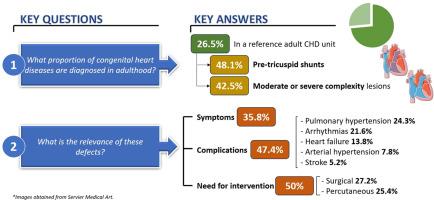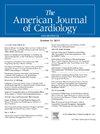Diagnosis of Congenital Heart Disease in Adulthood: How Often, How Relevant?
IF 2.1
3区 医学
Q2 CARDIAC & CARDIOVASCULAR SYSTEMS
引用次数: 0
Abstract
Congenital heart disease (CHD) is typically detected during fetal life, infancy, or early childhood. However, there is no published data regarding the proportion of congenital heart defects that are diagnosed in adulthood or the impact of these defects. Retrospective analyses of all consecutive patients (n = 1,010) referred to an adult CHD unit between 2018 and 2023. We analyzed the proportion of cases diagnosed in adulthood, defining the type of defect, reasons for diagnosis, complications, and need for intervention. In total, 26.5% of patients were diagnosed in adulthood (mean age 47 ± 16 years). Overall, 75% were in New York Heart Association class I/IV. Most were mild complexity lesions (57.5%). The most common diagnoses were pre-tricuspid shunts, including ostium secundum atrial septal defect (ASD, 23.9%), partial anomalous pulmonary vein drainage (18.3%), and other types of ASD (5.9%). Bicuspid aortic valve (16.8%) and aortic coarctation (8.2%) were common. Other diagnoses included Ebstein's anomaly (5.6%), ventricular septal defect (4.5%), patent ductus arteriosus (2.6%), or congenitally corrected transposition of the great arteries (2.6%). The main reason for diagnostic work-up was cardiac symptoms (28.4%) such as dyspnea (19%) and palpitations (7.1%), followed by incidental findings on imaging (25.4%). A total of 47.4% had some complications, the most common being pulmonary hypertension (24.3%). Surgical repair was required in 27.2% and 25.4% underwent percutaneous intervention. About one-fourth of patients with CHD were diagnosed in adulthood, and up to 42.5% had moderate or severe complexity lesions. A significant proportion had developed complications at the time of diagnosis and half of them required intervention.

成年后先天性心脏病的诊断:多频繁、多相关?
背景:先天性心脏病(CHD)通常在胎儿期、婴儿期或儿童早期发现。然而,目前还没有关于成年后确诊的先天性心脏缺陷比例或这些缺陷的影响的公开数据:回顾性分析2018-2023年间转诊至成人先天性心脏病科室的所有连续患者(N=1010)。我们分析了成年后确诊病例的比例,定义了缺陷类型、确诊原因、并发症和干预需求:其中,26.5%的患者在成年后确诊(平均年龄为 47±16 岁)。75%的患者属于 NYHA I/IV 级。大多数为轻度复杂性病变(57.5%)。最常见的诊断是三尖瓣前分流,包括房间隔缺损(ASD,23.9%)、部分肺静脉引流异常(18.3%)和其他类型的ASD(5.9%)。双尖主动脉瓣(16.8%)和主动脉瓣狭窄(8.2%)也很常见。其他诊断包括埃布斯坦氏异常(5.6%)、室间隔缺损(4.5%)、动脉导管未闭(2.6%)或先天性矫正的大动脉转位(2.6%)。诊断工作的主要原因是心脏症状(28.4%),如呼吸困难(19%)和心悸(7.1%),其次是造影偶然发现(25.4%)。47.4%的患者出现并发症,其中最常见的是肺动脉高压(24.3%)。27.2%的患者需要进行手术修复,25.4%的患者接受了经皮介入治疗:结论:约四分之一的先天性心脏病患者在成年后才被确诊,高达42.5%的患者有中度或重度复杂病变。很大一部分患者在确诊时已出现并发症,其中半数需要介入治疗。
本文章由计算机程序翻译,如有差异,请以英文原文为准。
求助全文
约1分钟内获得全文
求助全文
来源期刊

American Journal of Cardiology
医学-心血管系统
CiteScore
4.00
自引率
3.60%
发文量
698
审稿时长
33 days
期刊介绍:
Published 24 times a year, The American Journal of Cardiology® is an independent journal designed for cardiovascular disease specialists and internists with a subspecialty in cardiology throughout the world. AJC is an independent, scientific, peer-reviewed journal of original articles that focus on the practical, clinical approach to the diagnosis and treatment of cardiovascular disease. AJC has one of the fastest acceptance to publication times in Cardiology. Features report on systemic hypertension, methodology, drugs, pacing, arrhythmia, preventive cardiology, congestive heart failure, valvular heart disease, congenital heart disease, and cardiomyopathy. Also included are editorials, readers'' comments, and symposia.
 求助内容:
求助内容: 应助结果提醒方式:
应助结果提醒方式:


